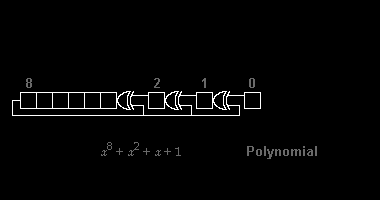This article is written like a manual or guide. (February 2023) |
The topic of this article may not meet Wikipedia's general notability guideline. (February 2023) |
Computation of a cyclic redundancy check is derived from the mathematics of polynomial division, modulo two. In practice, it resembles long division of the binary message string, with a fixed number of zeroes appended, by the "generator polynomial" string except that exclusive or operations replace subtractions. Division of this type is efficiently realised in hardware by a modified shift register,[1] and in software by a series of equivalent algorithms, starting with simple code close to the mathematics and becoming faster (and arguably more obfuscated[2]) through byte-wise parallelism and space–time tradeoffs.


Various CRC standards extend the polynomial division algorithm by specifying an initial shift register value, a final Exclusive-Or step and, most critically, a bit ordering (endianness). As a result, the code seen in practice deviates confusingly from "pure" division,[2] and the register may shift left or right.
- ^ Dubrova, Elena; Mansouri, Shohreh Sharif (May 2012). "A BDD-Based Approach to Constructing LFSRS for Parallel CRC Encoding". 2012 IEEE 42nd International Symposium on Multiple-Valued Logic. pp. 128–133. doi:10.1109/ISMVL.2012.20. ISBN 978-0-7695-4673-5. S2CID 27306826.
- ^ a b Williams, Ross N. (1996-09-24). "A Painless Guide to CRC Error Detection Algorithms V3.00". Archived from the original on 2006-09-27. Retrieved 2016-02-16.